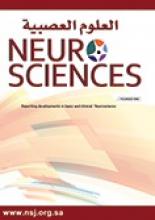Research ArticleOriginal Article
Open Access
Bibliometric analysis of Neurosciences research productivity in Saudi Arabia from 2013-2018
Amani H. Alhibshi, Widyan A. Alamoudi, Ikram Ul Haq, Shafiq Ur Rehman, Rai K. Farooq and Foziah J. Al Shamrani
Neurosciences Journal April 2020, 25 (2) 134-143; DOI: https://doi.org/10.17712/nsj.2020.2.20190087
Amani H. Alhibshi
From the Department of Neuroscience Research (Alhibshi, Alamoudi, Farooq), Institute for Research and Medical Consultations, Deanship of Library Affairs (Rehman), Imam Abdulrahman Bin Faisal University, and from the Department of Neurology (Al Shamrani), Imam Abdulrahman Bin Faisal University, King Fahd University Hospital, Dammam, and from the College of Dentistry (Ul Haq), King Saud bin Abdulaziz University for Health Sciences, King Abdullah International Medical Research Centre, Riyadh, Kingdom of Saudi Arabia.
MS, PhDWidyan A. Alamoudi
From the Department of Neuroscience Research (Alhibshi, Alamoudi, Farooq), Institute for Research and Medical Consultations, Deanship of Library Affairs (Rehman), Imam Abdulrahman Bin Faisal University, and from the Department of Neurology (Al Shamrani), Imam Abdulrahman Bin Faisal University, King Fahd University Hospital, Dammam, and from the College of Dentistry (Ul Haq), King Saud bin Abdulaziz University for Health Sciences, King Abdullah International Medical Research Centre, Riyadh, Kingdom of Saudi Arabia.
BSc, MSIkram Ul Haq
From the Department of Neuroscience Research (Alhibshi, Alamoudi, Farooq), Institute for Research and Medical Consultations, Deanship of Library Affairs (Rehman), Imam Abdulrahman Bin Faisal University, and from the Department of Neurology (Al Shamrani), Imam Abdulrahman Bin Faisal University, King Fahd University Hospital, Dammam, and from the College of Dentistry (Ul Haq), King Saud bin Abdulaziz University for Health Sciences, King Abdullah International Medical Research Centre, Riyadh, Kingdom of Saudi Arabia.
BA, MAShafiq Ur Rehman
From the Department of Neuroscience Research (Alhibshi, Alamoudi, Farooq), Institute for Research and Medical Consultations, Deanship of Library Affairs (Rehman), Imam Abdulrahman Bin Faisal University, and from the Department of Neurology (Al Shamrani), Imam Abdulrahman Bin Faisal University, King Fahd University Hospital, Dammam, and from the College of Dentistry (Ul Haq), King Saud bin Abdulaziz University for Health Sciences, King Abdullah International Medical Research Centre, Riyadh, Kingdom of Saudi Arabia.
MA, PhDRai K. Farooq
From the Department of Neuroscience Research (Alhibshi, Alamoudi, Farooq), Institute for Research and Medical Consultations, Deanship of Library Affairs (Rehman), Imam Abdulrahman Bin Faisal University, and from the Department of Neurology (Al Shamrani), Imam Abdulrahman Bin Faisal University, King Fahd University Hospital, Dammam, and from the College of Dentistry (Ul Haq), King Saud bin Abdulaziz University for Health Sciences, King Abdullah International Medical Research Centre, Riyadh, Kingdom of Saudi Arabia.
MS, PhDFoziah J. Al Shamrani
From the Department of Neuroscience Research (Alhibshi, Alamoudi, Farooq), Institute for Research and Medical Consultations, Deanship of Library Affairs (Rehman), Imam Abdulrahman Bin Faisal University, and from the Department of Neurology (Al Shamrani), Imam Abdulrahman Bin Faisal University, King Fahd University Hospital, Dammam, and from the College of Dentistry (Ul Haq), King Saud bin Abdulaziz University for Health Sciences, King Abdullah International Medical Research Centre, Riyadh, Kingdom of Saudi Arabia.
MD, SBN
References
- ↵
- Enache E,
- Marin C,
- Vechiu C
- ↵
- Kneller R
- ↵
- Nezu R,
- Chou SK,
- Ganguli P,
- Nithad K,
- Nishio K,
- Tansinsin LG,
- et al.
- ↵
- Markram H
- ↵
- Adolphs R
- ↵
- Albhaishi A,
- Wahsheh HA,
- Alghamdi T
- ↵
- Lancho-Barrantes BS,
- Guerrero-Bote VP,
- Moya-Anegón F
- ↵
- Marx W,
- Bornmann L
- ↵
- Haeffner-Cavaillon N,
- Graillot-Gak C
- ↵
- World Health Organization. [Internet]
- ↵
- Karthikeyan G,
- Manoharan A,
- Swaminathan S
- ↵
- Tadmouri GO,
- Tadmouri NB
- ↵
- Al-Khalifa HS
- ↵
- Rabaan AA,
- Al-Ahmed SH,
- Bazzi AM,
- Al-Tawfiq JA
- ↵
- Shehatta I,
- Mahmood K
- ↵
- Al-Bishri J
- ↵
- Rohra DK,
- Rohra VK,
- Cahusac P
- ↵
- Jamjoom A
- ↵
- Algahtani H,
- Shirah B,
- Boker F,
- Algamdi A,
- Alkahtani A
- ↵
- Jamjoom AA,
- Jamjoom BA,
- Jamjoom AB
- ↵
- Jamjoom AB
- ↵
- Baeesa SS,
- Maghrabi YE,
- Baeesa MS,
- Jan FM,
- Jan MM
- ↵
- Haq I,
- Al Fouzan K
- ↵
- Karam EG,
- Itani LA
- ↵
- Buchan AMJ,
- Jurczyk E,
- Isserlin R,
- Bader GD
- ↵
- Kocak M,
- García-Zorita C,
- Marugán-Lázaro S,
- Çakır MP,
- Sanz-Casado E
- ↵
- Shahabuddin SM
- ↵
- Xu W,
- Chen YZ,
- Shen ZC
- ↵
- Farooq RK,
- Syed Z,
- Zulqernain A
- ↵
- Abd-Allah F,
- Kissani N,
- William A,
- Oraby MI,
- Ramez Reda Moustafa RR,
- Shaker E,
- El-Tamawy MS,
- Shakirf R
- ↵
- Altalib HH,
- Elzamzamy K,
- Fattah M,
- Ali SS,
- Awaad R
- ↵
- Albilad Capital
- ↵
- Forero DA,
- Trujillo ML,
- González-Giraldo Y,
- Barreto GE
- ↵
- Smart T
- ↵
- Quansah E,
- Karikari TK
- ↵
- Balogun WG,
- Cobham AE,
- Amin A
- ↵
- Maina MB,
- Mohammed YG,
- Bukar AM,
- Ahmed U,
- Tajjani Salihu A,
- Ibrahim HA,
- et al.
- ↵
- Yeung AK,
- Goto TK,
- Leung WK
- ↵
- Alkuraya FS
- ↵
- Alsayea A
In this issue
Bibliometric analysis of Neurosciences research productivity in Saudi Arabia from 2013-2018
Amani H. Alhibshi, Widyan A. Alamoudi, Ikram Ul Haq, Shafiq Ur Rehman, Rai K. Farooq, Foziah J. Al Shamrani
Neurosciences Journal Apr 2020, 25 (2) 134-143; DOI: 10.17712/nsj.2020.2.20190087
Jump to section
Related Articles
- No related articles found.
Cited By...
- No citing articles found.





